Stages, Example Illustration, Solution - Rectification of errors | 11th Accountancy : Chapter 9 : Rectification of Errors
Chapter: 11th Accountancy : Chapter 9 : Rectification of Errors
Rectification of errors
Rectification of errors

Depending on the stage at which errors are located, they are
subsequently rectified at the respective stage itself.
1. Stages of rectification of errors
The following are the various
stages of rectification of errors:
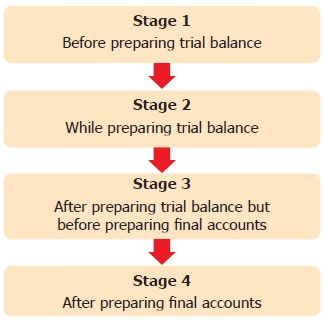
(i) Rectification of errors before preparing trial balance
If the accountant finds time before preparing trial balance to recheck
the entries made in the journal, postings in the ledger accounts, amounts
carried forward and balancing of ledger accounts with the intention of ensuring
their correctness, he/she will be able to locate and rectify the errors at that
stage itself.
(a) Rectification of one-sided errors before preparing trial balance
When one-sided error is detected before preparing the trial balance, no
journal entry is required to be passed in the books. In such cases, the error
can be rectified by giving an explanatory note in the account affected as to
whether the concerned account is to be debited or credited.

Illustration 1 (Errors in casting)
The following errors were detected before the preparation of trial
balance. Rectify them.
a. Sales book is undercast by
Rs. 100
b. Sales book is overcast by
Rs. 200
c. Purchases book is undercast by
Rs. 300
d. Purchases book is overcast by Rs. 400
Solution

Note


Illustration 2 (Errors in casting)
The following errors were
detected before preparation of trial balance. Rectify them.
a. Purchases returns book is undercast by Rs. 500.
b.
Purchases
returns book is overcast by Rs. 600.
c.
Sales
returns book is undercast by Rs. 700.
d.
Sales
returns book is overcast by Rs. 800.
Solution

Illustration 3 (Errors in carry forward)
The following errors were detected before preparation of trial balance.
Rectify them.
a.
The total
of purchases book is carried forward to the next page Rs. 100 short.
b.
The total
of purchases returns book is carried forward to the next page Rs. 200 excess.
c.
The total
of sales book is carried forward to the next page Rs. 300 excess.
d.
The total
of sales returns book is carried forward to the next page Rs. 400 short.
Solution

Illustration 4 (Errors in carry forward)
The following errors were
detected before preparation of trial balance. Rectify them.
a.
The total
of rent received account is carried forward Rs. 900 short.
b.
The total
of rent received account is carried forward Rs. 1,000 excess.
c.
The total
of salary account is carried forward Rs. 1,100 short.
d.
The total
of salary account is carried forward Rs. 1,200 excess.
Solution

Illustration 5 (Errors in posting)
The following errors were
detected before preparation of the trial balance. Rectify them.
a.
A sum of Rs. 5,000 written off as depreciation
on buildings has not been posted to depreciation account.
b.
Payment
of wages Rs. 2,000 to
Venkat was posted twice to wages account.
c.
An amount
of Rs. 250 for a
credit sale of goods to Nila, although correctly entered in the sales book, has
been posted as Rs. 200.
Solution

(b) Rectification of two-sided errors before preparing the trial balance
When a two-sided error is detected before preparing the trial balance,
it must be rectified by passing a rectifying journal entry in the journal
proper after analysing the error.
Practical steps to be followed in rectifying two-sided errors

Illustration 6
The following errors were located
before the preparation of the trial balance. Rectify them.
a.
Goods
sold to Anand for Rs. 1,000 on
credit was not entered in the sales book.
b.
An amount
of Rs. 400 paid for
repairs to the machinery stands wrongly posted to machinery account.
c. Salaries Rs. 2,000 paid to Gandhiraj was wrongly debited to his personal account in the ledger.
Solution
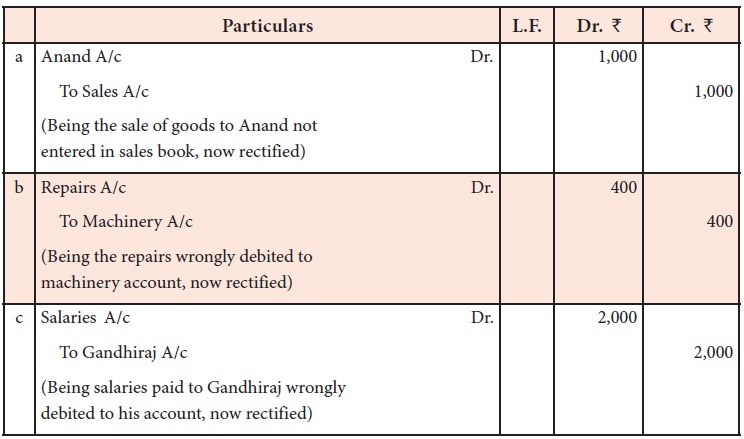
Method of deriving the rectifying entries
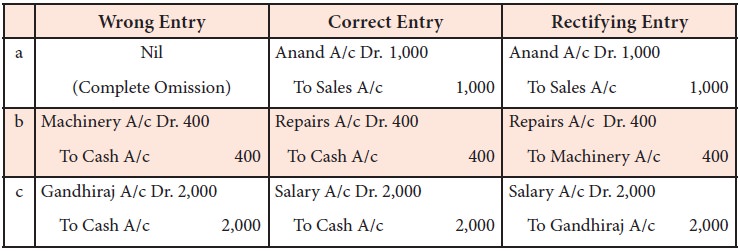
Note
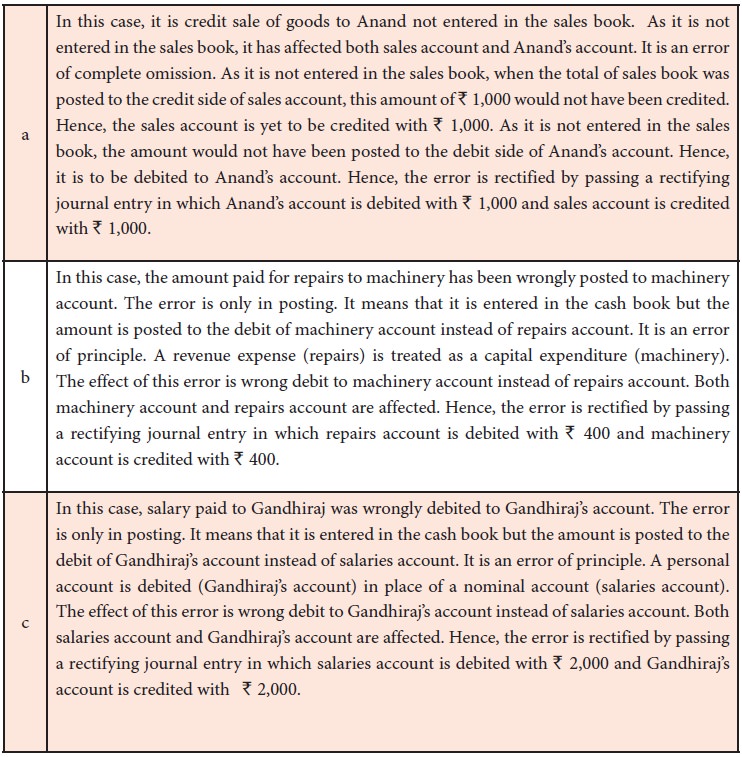
Illustration 7
The following errors were located
before the preparation of the trial balance. Rectify them.
a.
Paid Rs. 500 to Angappan were wrongly
debited to Angannan’s account.
b.
Sale of
furniture for Rs. 750 was
credited to sales account.
c.
Purchase
of goods from Bagya for Rs. 2,100 was wrongly passed through sales book.
d.
Wages Rs. 1,000 paid on erection of
machinery were debited to wages account.
Solution

Method of deriving the rectifying entries
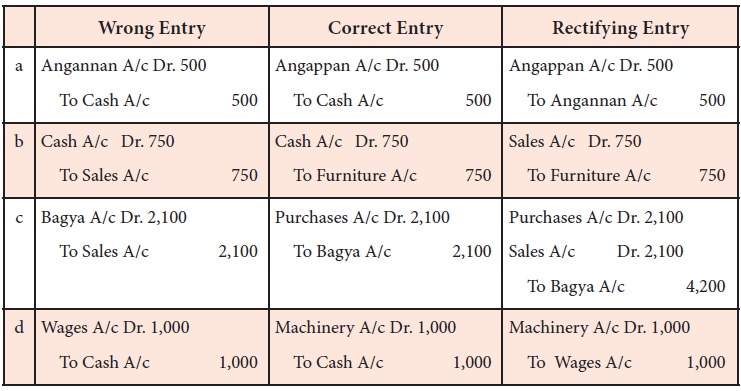
(ii) Rectification of errors while preparing the trial balance
Errors can be rectified at the
time of preparing the trial balance as follows:
(a) Rectification of one-sided errors while preparing the trial balance
While preparing the trial balance, if the total of debit balances and
credit balances are not the same, there is disagreement of trial balance. It
shows that there are errors in the books of accounts. As a consequence, the
accountant may start locating errors before closing the trial balance. In such
cases, the errors are rectified at that stage itself. At this stage, the
rectification of one-sided errors is made in the same manner as in the case of
rectification before preparing trial balance. Rectifying journal entries are
not required to be passed in the books. In such cases, errors can be rectified
by giving an explanatory note in the account affected.![]()
Illustration 8
The following errors were located at the time of preparation of the
trial balance. Rectify them.
a.
Sale of
goods to Akila on credit for Rs. 1,520 posted to her account as Rs. 1,250.
b.
Bought
goods from Narendran on credit for Rs. 5,500, credited to his account as Rs. 5,050.
c.
Purchase
of furniture from Ravivarman for Rs. 404 on credit were debited to furniture
account as Rs. 440.
d.
Purchased
machinery for cash Rs. 2,000 was
not posted to machinery account.
e.
The total
of purchases book Rs. 899 was carried
forward as Rs. 989.
Solution

(b) Rectification of two-sided errors while preparing the trial balance
Rectification of two-sided errors at the time of preparing the trial
balance is just similar to that of their rectification before preparation of
trial balance.
Illustration 9
The following errors were located at the time of preparation of the
trial balance. Pass rectifying entries.
a.
Goods of
the value of Rs. 100 returned
by Bhuvana were included in stock, but no entry was made in the books.
b.
Sale of
goods to Mani on credit for Rs. 475 has been wrongly entered in the sales book
as Rs. 745.
c.
A cheque
of Rs. 500 received
from Sandhiya was dishonoured and debited to allowances account.
d.
A sum of Rs. 300 drawn by the proprietor for
personal use was debited to wages account.
![]()
Solution
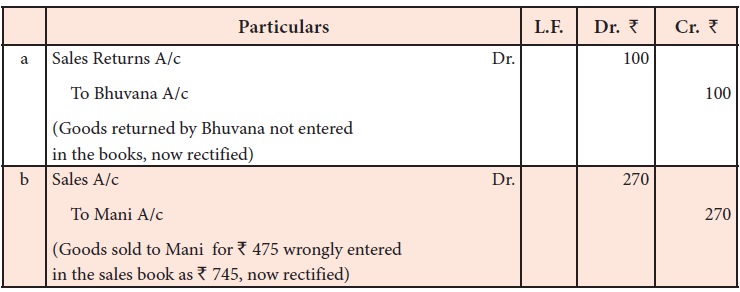
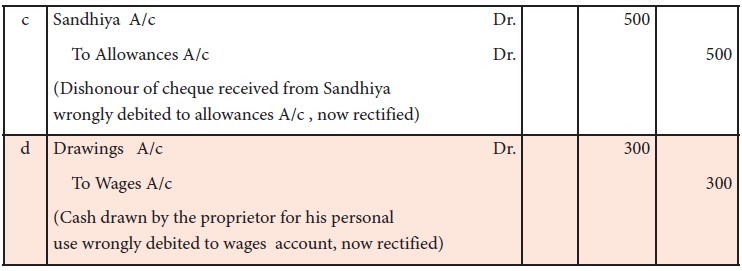
Method of deriving the rectifying entries
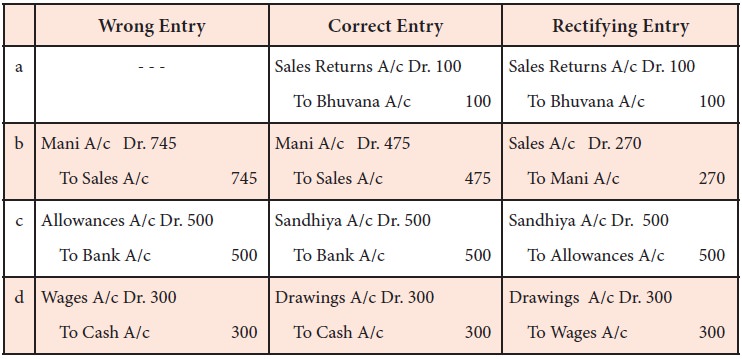
(iii) Rectification of errors
after preparing the trial balance but before preparing the final accounts
(a) Rectification of one-sided errors after preparing the trial balance
If there is disagreement of trial balance and if it is not possible
immediately to locate errors, the accountant may place the difference to
‘suspense account’. After that, before the preparation of final accounts, the
entries, postings, castings, balancing of accounts and amounts carried forward
are scrutinised to locate the errors.
At this stage, every one-sided
error is rectified by passing a rectifying journal entry with the respective
account (debited or credited) and suspense account (credited or debited). The
suspense account is used to rectify such errors so that the difference in trial
balance placed to that account gets adjusted. Once all the one-sided errors are
completely rectified, the balance in the suspense account gets eliminated.
Illustration 10
The following errors were located after the preparation of the trial
balance. Assume that there exists a suspense account. Rectify them.
a.
Sale of
goods on credit to Arun for Rs. 152 posted to his account as Rs. 125.
b.
Bought
goods from Lakshmi on credit for Rs. 550, credited to her account as Rs. 505.
c.
Purchase
of furniture from Abirupa for Rs. 404 on credit was debited to furniture account
as Rs. 440.
d.
Purchased
machinery for cash Rs. 200 was not
posted to machinery account.
e.
The total
of purchases book Rs. 89 was
carried forward as Rs. 98.
Solution
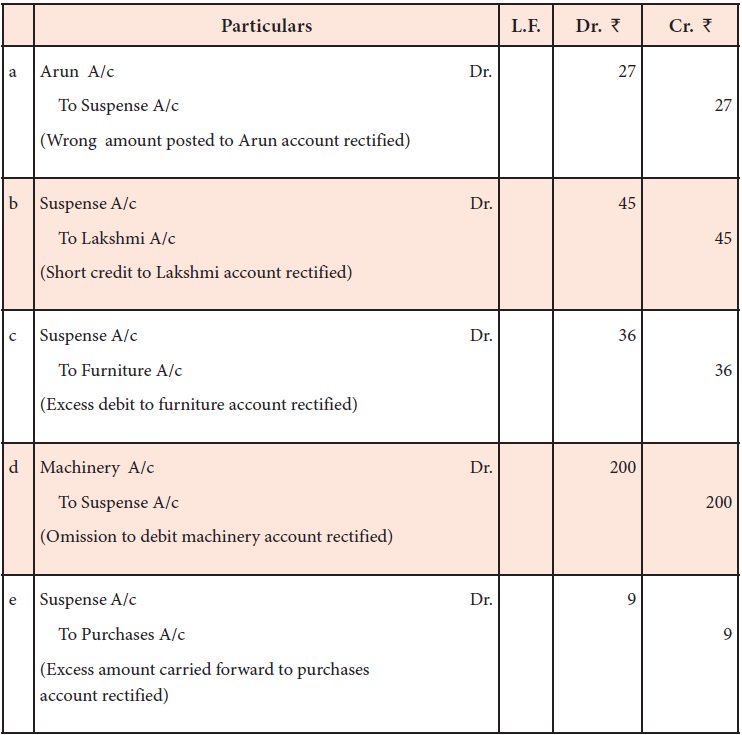
Tutorial note
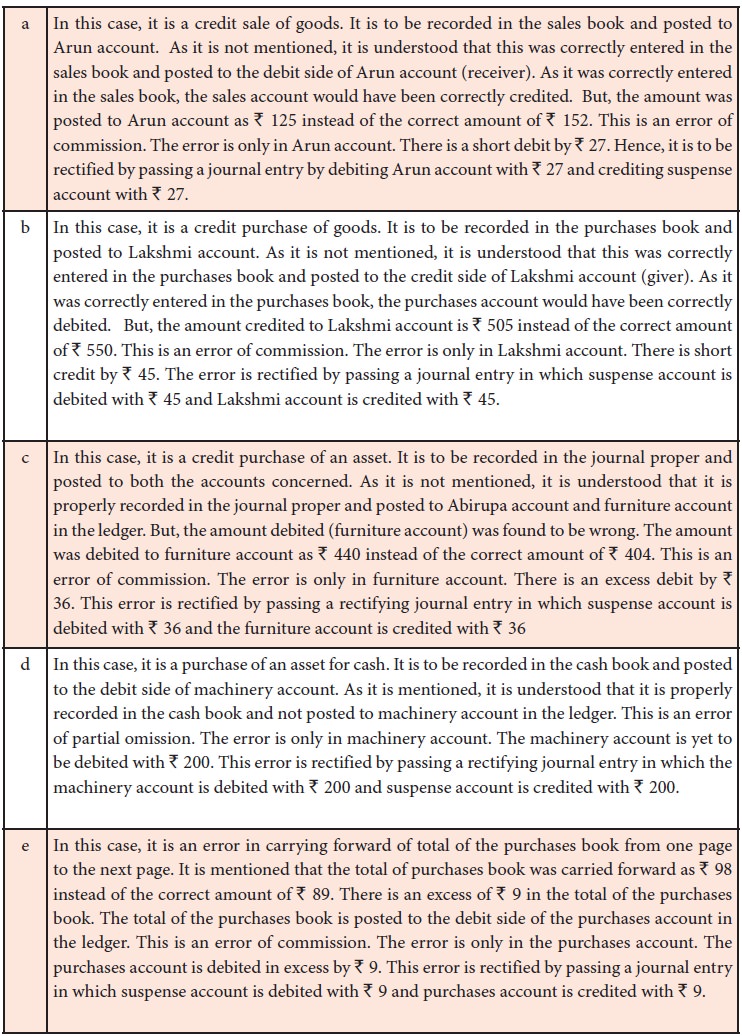
Illustration 11
The following errors were located after the preparation of the trial
balance. Assume that there exists a suspense account. Pass journal entries to
rectify them.
a.
The total
of purchases book was undercast by Rs. 100.
b.
The total
of the discount column on the debit side of cash book Rs. 575 were not posted.
c.
The total
of one page of the sales book for Rs. 5,975 were carried forward to the next page as
Rs. 5,795.
d.
Salaries Rs. 1,800 were posted as Rs. 18,000.
e.
Purchase
of goods on credit from Mukilan for Rs. 150 have been posted to his account as Rs. 1,500.
Solution

(b) Rectification of two-sided errors after preparing the trial balance
At this stage, every two-sided
error is rectified by passing a rectifying journal entry by debiting one of the
accounts affected and crediting the other account. As these errors do not cause
difference in trial balance, the suspense account is not used in the rectifying
journal entries. Therefore, the rectifying entries passed for rectifying
two-sided errors before preparation of trial balance and after preparation of
trial balance are the same.
Illustration 12
The following errors were located after the preparation of the trial
balance. Rectify them.
a.
Paid Rs. 50 to Anitha was wrongly debited
to Vanitha account.
b.
Sale of
furniture for Rs. 500 was
credited to sales account.
c.
Purchased
goods from Natarajan on credit for Rs. 750 were wrongly passed through sales book.
d.
Wages Rs. 1,000 paid on erection of
machinery was debited to wages account.
Solution
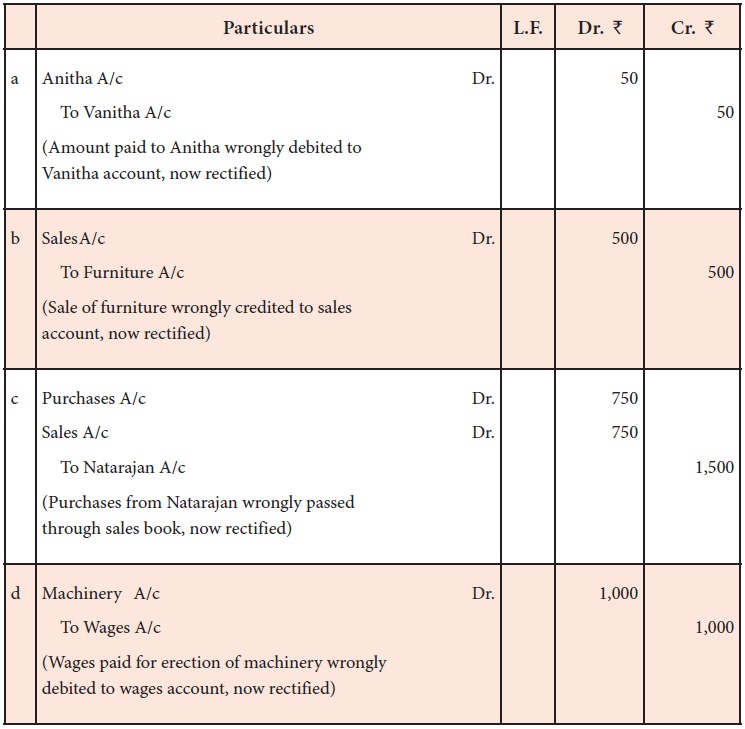
Illustration 13
Rectify the following journal
entries.
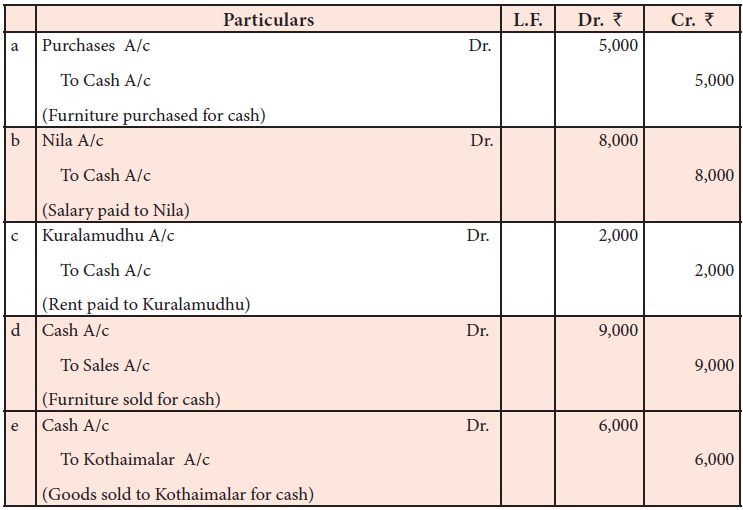
Solution
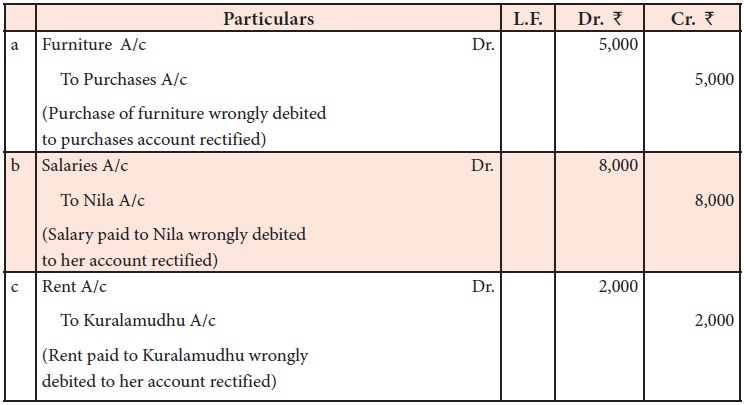
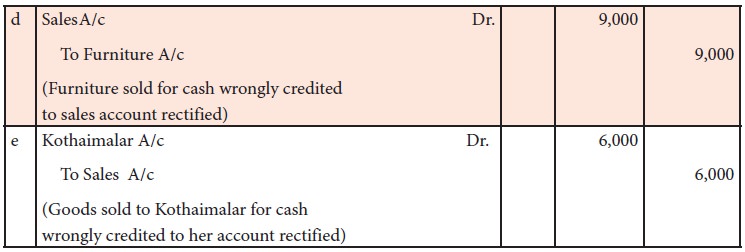
Illustration 14 (One-sided errors and two-sided errors)
Pass journal entries to rectify the following errors located after the
preparation of the trial balance. Assume that there exists a suspense account.
a.
The total
of sales book was undercast by Rs. 2,000.
b.
The
purchase of machinery for Rs. 3,000 was entered in the purchases book.
c.
A credit
sale of goods for Rs. 45 to Mathi
was posted in his account as Rs. 54.
d.
The
purchases returns book was overcast by Rs. 200.
e. The total of sales book Rs. 1,122 were wrongly posted in the ledger as Rs. 1,222.
Solution
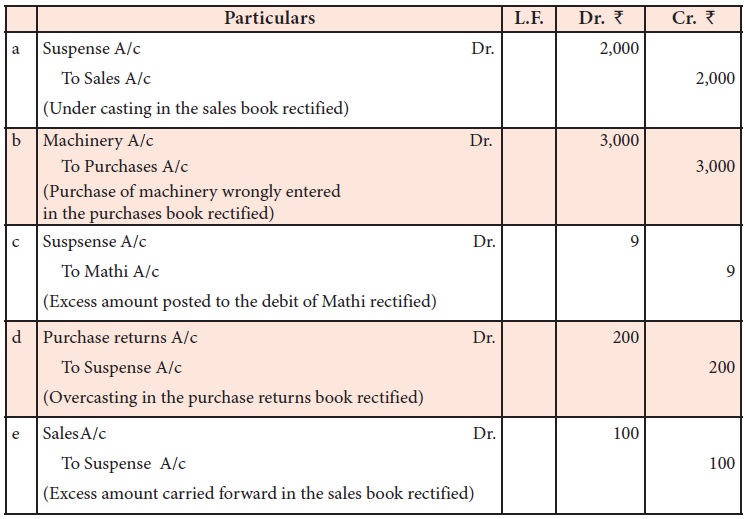
Illustration 15 (One-sided errors and two-sided errors with preparation of suspense account)
A book-keeper finds that the debit column of the trial balance is short
by Rs. 308 and the difference is put to a suspense
account. Subsequently, the following errors were located.
a.
An entry
for sale of goods on credit for Rs. 102 to Mekala was posted to her account as Rs. 120.
b.
Rs. 100 being the monthly total of discount allowed to
customers was credited to discount
received account in the ledger.
c.
Rs. 275 paid by Mannan was credited to Kannan account.
d.
Rs. 26 appearing in the cash book as paid for the
purchase of stationery for office use has not
been posted to ledger.
e.
The
purchases book was undercast by Rs. 100.
Rectify the errors and prepare
supense account.
Solution
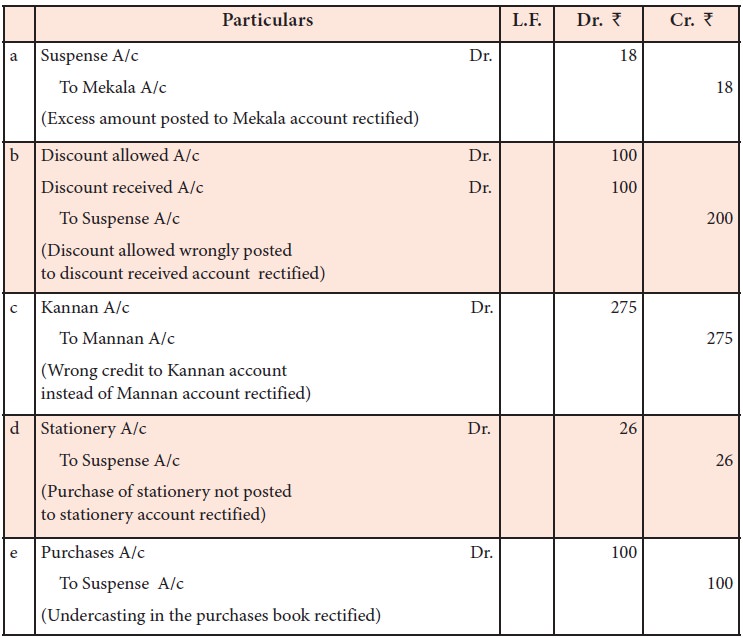
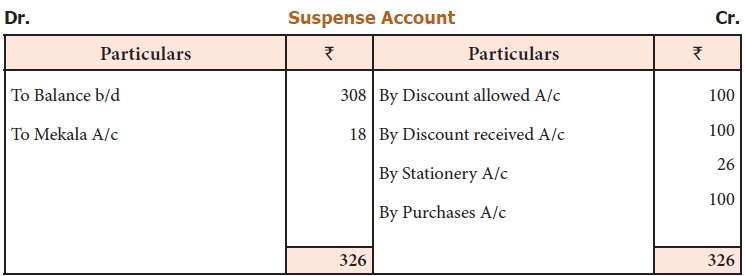
(iv) Location and rectification of errors after preparing the final accounts
Sometimes, though there is disagreement of trial balance, due to lack of
time and urgency in the completion of final accounts, the accountant may not
locate and rectify the errors. Under such circumstances, the difference in
trial balance is placed to the suspense account, which may show either debit
balance or credit balance. If it shows a debit balance, it is shown on the
assets side. If it shows a credit balance, it is shown on the liabilities side.
The errors will be located and rectified by the accountant during the next
accounting period. If the error to be rectified is in a nominal account, it
affects the profit or loss of the business. Hence, instead of debiting or
crediting them for rectification, profit and loss adjustment account is debited
or credited. If the error to be rectified is in a real account or personal
account, the respective real account or personal account itself is debited or
credited for rectification. After all the errors are rectified, the net effect
on profit is calculated by preparing profit and loss adjustment account and the
balance is transferred to capital account.
Related Topics